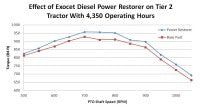Given much thought to your red diesel lately?
The fact that the specification for red diesel (BS2869:A2 gas oil) changed significantly in January last year passed many people by, including, it has to be said, many regular users. This is not to say that regular users of red diesel aren't experiencing problems or aren't questioning the operability of their machinery - in fact, the reverse is true. So, what is going on, and what has changed?
Neil Ryding, Managing Director of FAST ) Fuel Additive Science Technologies), explains.
The manufacturers of modern diesel engines, whether they be for on-road or off-road use, are coming under increasing pressure to comply with stringent time-scales on emissions reduction from their engines. As a result, a huge amount of time and effort has been, and is being, devoted to the mechanical design of an engine and its exhaust system in order to minimise noxious gaseous and particulate emissions. Consequently, ever tighter tolerances are being seen in the sophisticated fuel injection systems in an attempt to maximise combustion efficiency, and the inclusion of sensitive exhaust after treatment devices is now commonplace. So far, so good on the engine, but is the UK's red diesel up to the job? This question is important, as the vast majority of modern engines are calibrated to run on DERV - EN590. Evidence over the past 12 months suggests that many vehicles running on red diesel require a little 'help' if they are to operate at optimum performance.
Fuel
Since the start of 2011, in order to help with the performance of catalyst-based exhaust treatments, and via an EU Fuel Quality Directive, the maximum sulphur

What Does This Mean for the End-User?
Lowering the sulphur content of a fuel is nothing new: road diesel and petrol jumped this hurdle without much problem some time ago. Talking sulphur out, however, does reduce the 'oilyness' of fuel - its natural lubricating properties - as during the removal process some extremely useful lubricating hydrocarbons are also lost. This matters, as a lower fuel 'lubricity' results in excessive or premature wear in the very close-tolerance parts of common-rail injection pumps and injectors. The current specification does counter this by specifying a lubricity measure, and fuel supplied to this specification should, of course, cause no problems. Note that fuels substantially exceeding this minimum lubricity specification can benefit from improved fuel economy.
The second change affecting the maximum biodiesel content is potentially the more questionable. At a maximum 7% by volume, it is now equivalent to the DERV specification. Whilst more biodiesel in the fuel does increase its lubricity, it does have a number of downsides, including:
• a much-increased water pick-up potential, leading to a decrease in calorific value, increased corrosion rates and damaged filters
• a reduced cold-weather handling performance
• an increased incidence of microbiological growth - the 'diesel bug'- leading to sludge problems, blocked filters and fuel starvation
• the promotion of 'layering effects' in bulk storage
• a much reduced fuel shelf life which can lead to sludge from fuel oxidation products
• increased deposit forming tendencies
This last point is critical as it can lead to restricted flow in the injection system, which in common-rail engines, where injection pressures are extremely high and spray patterns complex, can result in catastrophic failure of the injectors themselves.

Here, in the UK and Ireland, we are out of step with the rest of Europe, which uses DERV produced to EN590 with a minimum cetane number of 51 to power its off-road vehicles: given the constraints and expectations being placed on them, global engine manufacturers are reluctant to supply or calibrate engines just for the UK and Ireland.
What Is Being Delivered As Red Diesel?
Red diesel should be supplied according to BS2869:A2 gas oil, but recent evidence suggests that fuel distributors or end-users rarely see a detailed delivery note or a certificate of analysis to this effect, and much is taken at face value and on trust. The words 'gas oil' or 'red diesel' in themselves are generic terms that mean nothing and everything at the same time and, whilst it is not a legal requirement to provide a specification, without one the consumer is blind to what he is receiving.

Much is also made of the supply of 'FAME-free fuel' (i.e. containing no biodiesel). This is increasingly a tough claim to make. As has been explained, biodiesel can be included in both red diesel and DERV and, indeed, all road fuel should contain a minimum of 5% renewable content by April 2013 under the Road Transport Fuel Obligation. It should be assumed, therefore, that biodiesel is present already throughout the UK's diesel pool, at least by the effects of co-mingling, unless your supplier is prepared to put it in writing that it is not. Note also that some parts of Europe allow B20 fuel (20% biodiesel content), and the more often that fuel is moved around Europe and imported into the UK (as is increasingly the case), then the more likelihood of an increased bio-content in the UK diesel supply.
Another common claim is that red diesel is simply DERV with a red dye added, and you are getting 'premium fuel' at red diesel pricing. If you are lucky, this may be the case but, again, it can't be assumed, and our recent evidence is that the UK's refineries continue to produce two distinct products or are importing increasing quantities of low grade diesel for use as gas oil.
In summary, therefore, there is now huge potential for variability in the off-road bulk fuel, and fuel-quality related problems continue to emerge on a routine basis. In addition, it is difficult for consumers to discover what is being delivered. The Department for Transport's 'Fuel Quality Directive Gas Oil Requirements' suggests that fuel stocks are turned over at least every six months, and this advice is echoed by various other sources.
Vehicle manufacturers and suppliers now specify the expected fuel quality and/or required fuel additives in the vehicle manuals, and are increasingly prickly about warranty claims made for a vehicle run on non-approved fuel, especially if it involves the exhaust after treatment.

Fuel additives and conditioners are available in different forms from a number of companies. They set out to do several jobs, either as problem-specific individual fuel treatments or as broad-spectrum products.
Typically, additives can do one or more of the following:
• Raise the fuel cetane number, usually to a minimum of 51
• Increase fuel lubricity - the 'oilyness' of the product
• Dissolve and remove deposits from the injection system components
• Counter fuel oxidation during storage
• Encourage water to come out of suspension in the fuel so existing water traps can remove it
• Lower the temperature at which waxing starts to occur
• Counter any increase in microbiological activity within the fuel
The use of such additives is now commonplace in the agricultural and construction sectors and, whether you regard them as positive benefits, necessary evils or insurance policies, they are worth a closer look.
